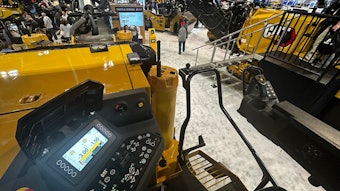
Like many industries, construction is in the middle of a transition away from gas and toward electrical power. Overall demand for lithium-ion batteries is expected to increase by more than 30% annually between now and 2030, according to the consultancy firm McKinsey.
While the power tool space has long since transitioned to cordless technology with the lithium-ion battery, light equipment is now experiencing its own mass electrification as lithium-ion battery technology has continued to evolve. Delivering greater power, longer run times, and more reliable performance, a growing slate of battery-powered equipment systems is now able to compete in an arena that’s been dominated by gas engines for decades.
The Benefits of Electrification
The shift toward electrification is driven by many safety and productivity benefits that make cordless solutions increasingly attractive to construction companies, general contractors, and skilled trade workers. A major advantage to battery-powered systems is that they eliminate gas headaches by removing noxious emissions and lowering noise levels. Some cordless equipment systems also provide a unified platform of solutions, all powered by the same interchangeable batteries.
Furthermore, battery-powered alternatives are more reliable than gas, with push-button starts that consistently work under any conditions. Meanwhile, substantial government incentives are making the long-term investment in cordless electric systems more palatable than ever. Finally, a growing number of cities and states are beginning to pass laws that restrict the use of gas-powered equipment as lithium-ion battery technology evolves to deliver greater performance and sustainability benefits.
No Gas Headaches
As the Centers for Disease Control notes, skilled trades professionals who regularly work with fume-emitting gas engines are at a higher risk of life-threatening carbon monoxide poisoning. Gas emissions are especially damaging to workers when concentrated in indoor job sites and confined spaces with poor ventilation. Compared to gas alternatives, cordless power tools and equipment can be safely operated for longer periods without the need to install specialty ventilation to mitigate emissions.
Less Noise
Another benefit of battery power is its potential to dramatically reduce noise pollution on the jobsite. Roughly 22 million workers are exposed to dangerous levels of noise in the workplace every year, according to the CDC. Battery-powered tools and equipment are much quieter in comparison, making for a safer and more productive jobsite. The lowered level of noise not only reduces the risk of hearing loss, but also makes it easier for operators to communicate with one another, improving safety on the professional jobsite.
More Reliable
Cordless tools are more reliable than gas engines, with push-button starts that work every time. Comparatively, starting gas-powered equipment can be difficult, time-consuming, and inconsistent. With battery-powered equipment, you no longer need to worry about priming and choking the engine, ensuring the on/off switch and throttle are in the correct position, or tricky pull-starts that jam up or simply refuse to turn the engine over. With lithium-ion battery power, starting even the most heavy-duty piece of power equipment is as simple as pressing a button.
 Battery-powered tools and equipment are much quieter than their diesel counterparts, making for a safer and more productive jobsite.Milwaukee Tool
Battery-powered tools and equipment are much quieter than their diesel counterparts, making for a safer and more productive jobsite.Milwaukee Tool
Government Incentives
State and federal tax credits are a popular mechanism that governments use to encourage the adoption of more sustainable electrical alternatives to gas engines. Contractors are well-positioned to take advantage of these tax credits, provided they’re willing to take the leap to electrification. Under the IRA, for example, construction companies and other businesses may be eligible to receive up to $40,000 in federal tax credits for purchases of electric commercial vehicles.
Long-Term Investment
Electrifying your inventory can save contractors time and money long-term by eliminating fuel and engine maintenance expenses. With a single system of compatible batteries, contractors can simply recharge their battery-powered tools and equipment using on-site electrical utilities instead of paying for gas. Meanwhile, battery power doesn’t have the same upkeep needs as gas engines, which routinely require parts like air filters and pull-start cords to be replaced.
Changing Legislation
Depending on where you live, it may no longer be legal to use certain types of gas-driven tools and equipment. Concerned about their negative environmental impacts, a growing number of cities and states have advanced laws restricting the use of gas-powered outdoor power equipment in recent years.
Battery Technology Innovation
Cordless tools and equipment are in a constant state of evolution. The lithium-ion batteries of today run longer, charge faster, are much more powerful, and more reliable than their ancestors from 10 years ago. Meanwhile, the efficiency and power of gas engines has remained largely unchanged over the last several decades. Advancements like these position cordless tools and equipment to surpass gas-driven alternatives in the years to come.
Bottom Line
The construction industry’s shift toward battery-powered tools and equipment is being driven by the increased productivity and versatility these solutions can introduce to the jobsite. With power tools having already cut the cord, construction equipment is now poised for an electric revolution of its own as the overall demand for lithium-ion power rises over the next decade. Global factors aside, it is difficult to deny the many advantages of converting to an all-electric inventory. From their elimination of gas headaches to their constant evolution, battery-powered tools and equipment deliver a range of benefits that increase efficiency and improve safety on the jobsite.


























